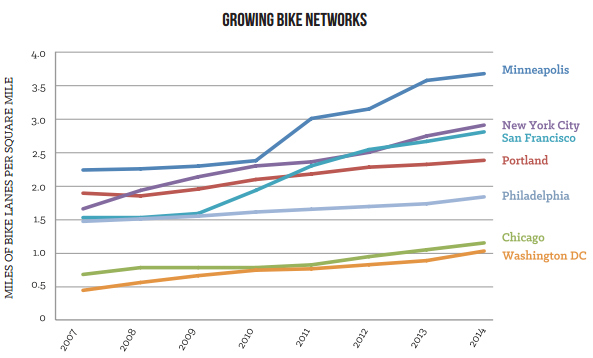
While Portland celebrates a strong first day for Biketown, a new report about the factors that drive growth in bike sharing shows how Portland has fallen behind the leading U.S. cities in new infrastructure.
Minneapolis, New York City and San Francisco now have about 50, 20 and 15 percent more bikeways per square mile than Portland respectively, the report found. All three of those cities has seen faster bikeway growth than Portland since 2010, the year Portland passed its ambitious Bike Plan for 2030. In Minneapolis, bike infrastructure has grown three times faster.
These new figures were released Wednesday as part of a report by the National Association for City Transportation Officials, which examined the role quality bike networks play in making bike sharing safe and popular.
Kate Fillin-Yeh, the report’s author, said in an email Wednesday that the city totals include bike boulevards, which in Portland are called neighborhood greenways. The neighborhood greenway system was the city’s major investment in new bikeways under Mayor Sam Adams, but in part because the city has relied on slow-churning state and federal grants, some projects that began under Adams — the 20s Bikeway, for example, or the 4M Neighborhood Greenway — have yet to be built years later.
Mayor Charlie Hales essentially killed the neighborhood greenway program in 2013 amid a post-recession budget crunch. Only small bits of new bikeway mileage have arrived on city streets since, though Hales did later create a program to add speed bumps and diverters to existing neighborhood greenways.
Advertisement
NACTO’s report marked the first time in five years that someone has gathered this data for multiple cities. It was included in a 2012 report from the Alliance for Biking and Walking but hasn’t been part of follow-up editions.
The report focused in particular on the ways bike infrastructure tends to drive up ridership, which in turn increases safety.
The connection between bike share ridership and high-quality bike lanes is clear: people ride more when they have safe places to ride. Less explored is the positive feedback loop between bike share, the creation of protected bike networks, and overall cyclist safety – and the importance of this feedback loop in helping to address the systemic inequities in the U.S. transportation system.
It also discussed the fact that people who identify as black or Hispanic are more likely to die on a bicycle than people who identify as white, Asian or Pacific Islander.
An analysis from the League of American Bicyclists found that Black and Hispanic cyclists had a fatality rate 30% and 23% higher than white cyclists, respectively, and similar racial/ethnic safety gaps are found for pedestrians. In focus groups and surveys, low-income people and people of color cite concerns about safety and lack of bike lanes as a main reason not to ride.
Does this report mean Portland is no longer the best large city to bike in? No. As the report notes, the point of bike infrastructure is to increase ridership and improve safety. Portland currently beats these rival cities on both measures — even though Portland’s city limits happen to include plenty of bike-unfriendly areas.
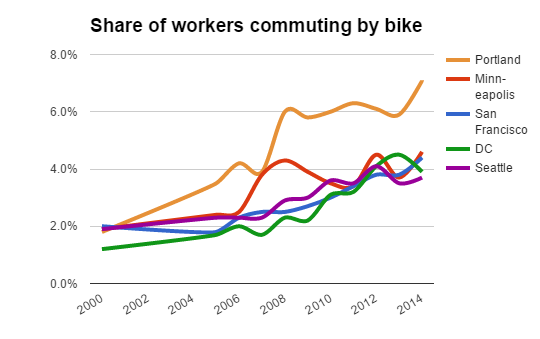
What the report means is that compared to those cities, biking hasn’t been improving much in Portland.
For example, the probability of a traffic death or serious injury for people on bikes in Portland fell sharply in the 2000s, but has rebounded a bit since 2010:
There’s reason to hope that Portland is finally turning a corner on infrastructure. Some of that slow-churning state and federal money is finally arriving on the streets. Because the new local gas tax won’t have complicated strings attached, projects should be able to move faster.
And this summer’s burst of bike improvements for NW Naito, N Mississippi, SE Ankeny and NW/SW 2nd Avenue, plus the nine small protected bike lane projects in progress around the city, seem to suggest a new urgency in city government to make streets safe for a surge of new bike-share users, among others.
Making our bike-sharing system successful definitely isn’t the only reason to improve city streets. But with luck, it’ll help focus the city’s attention around the need.
— Michael Andersen, (503) 333-7824 – michael@bikeportland.org
Our work is supported by subscribers. Please become one today.


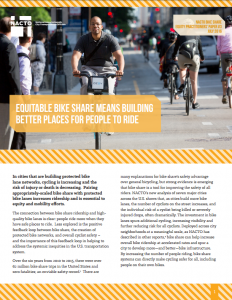
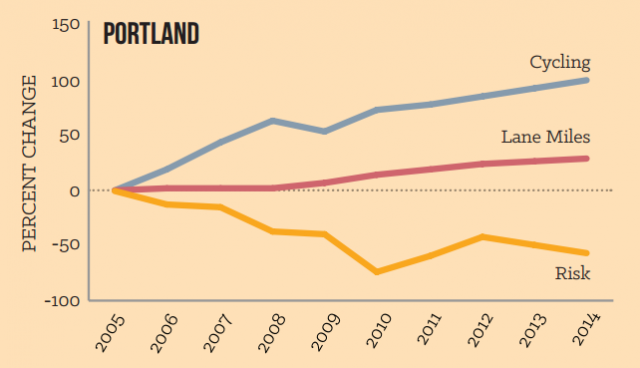
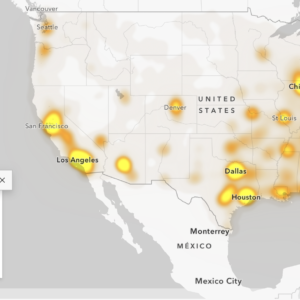
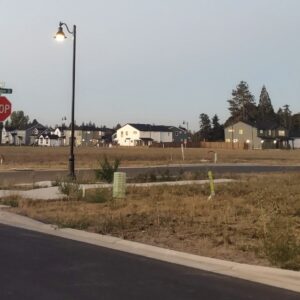

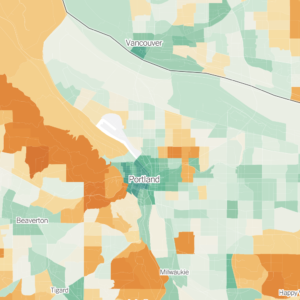
Thanks for reading.
BikePortland has served this community with independent community journalism since 2005. We rely on subscriptions from readers like you to survive. Your financial support is vital in keeping this valuable resource alive and well.
Please subscribe today to strengthen and expand our work.
There’s bike lanes and there are bike lanes. Portland, and Oregon as a whole, tend to put in overly narrow bike lanes with things like severe crowning, gutter apron issues and almost completely in the door-zone (which extends twelve feet from the curb). Those sort of bike lanes aren’t going to win any people to riding bikes long term. Bike lanes that are clear of door-zone issues, at least six feet (and preferably closer to eight feet) wide so that there aren’t gutter issues are an entirely different game. Counting total miles misses this entirely.
Another place we fall down is our consistent way of putting little missing pieces into almost everything and just ignoring them for years and years while we congratulate ourselves on a job almost finished. Imagine a car bridge over the river that is only missing the middle ten feet. Sure, some folks with local knowledge will simply speed up to 90 mph and jump the gap, but no one would call this something to celebrate no matter how long the bridge is.
I think about this every time I ride the bike lanes on east Burnside near 82nd. They are scary if you are on a go-fast bike, and absolutely terrifying if you are riding with children. Completely unacceptable infrastructure.
Even the current standard minimum 5.5 foot lanes are awful. I won’t even ride in the six-foot bike lanes in front of my house on SE 52nd because the southbound lane is too close to parked cars, both lanes are too close to moving motor traffic, and the motor traffic volume is way too high (exceeds triple the minimum threshold for a bikeway). Even six foot bike lanes aren’t good enough when they’re completely unprotected and sandwiched between parked cars and unimpeded 30+ mph motor traffic –the entire stretch from Division to Powell has no stop signs and only one marked crosswalk.
However, a 7-foot wide lane is essentially a “parking lane”, and 8 feet or wider is an “HOV Lane”, even in Portland, as several folks on this very blog have frequently pointed out.
“HOV lane”, heh. Very true.
Hence why paint is basically useless. There needs to be vertical separation, either using bollards or a curb.
BOLLARDS! My favorite divider to stop cars, trucks, and tanks! 🙂
These finding will surprise literally no one who lives in Portland. The fact that we have just two miles of dedicated, separated, and protected bicycle infrastructure in the central city should be considered an embarrassment.
The true embarrassment is that the bike community leadership is too cozy with the oppressors of the bike community. – Maus neglected to say his name: Novick.
Slow and quiet leadership is a form of oppression. I’ve noted our oppressors and 5 simple ways to put a lot more people on bikes and help people who want to feel safe and dive less. Every day can be Sunday Parkways for zero dollars. It only takes one city hall meeting for the leaders to step aside and let people lead.
Here’s my news link on all the details to prove my point
https://docs.google.com/document/d/1odUY1ujfq2yexerGd4qk5JYPVmoe-1GFKFgPYZoKye0/edit?usp=sharing
In the link above you can add comments inline with the text.
As a former Portland resident, and now Minneapolis resident, I have to say, that one has to be very careful about relying on infrastructure as a deciding factor when it comes to quality of city cycling. Minneapolis may have more paths, but the overall driver culture and animosity toward cyclists is much worse in Minnesota than I Oregon. Infrastructure aside, one also needs mature “culture”. In other words, cycling needs to be generally acceptable and bikers need to be treated as equal participants in traffic. Needless to say cyclist also need not to be jerks and they need to obey traffic laws. Sadly both motorized and cycling culture in Minneapolis are still quite immature, and the Twin Cites have a long way to go before they can be truly comparable to PDX.
I’d have to agree. DC, for example, just passed a law against “contributory negligence.” This means that before this law was passed, if a cyclist was at least 1% at fault, they were not eligible for compensation. Imagine how shitty it would be to be hit by a car, and be told you were 1% at fault. Sorry.
Streets in the DMV are also designed much more towards keeping cars going fast with minimal pedestrian separation and other facilities. In Portland thanks to PBOT and friends there is a movement to have safe crossings and pedestrian extensions. This is not even on the radar in DC and surrounding environs. And as Portland will find out very soon, good pedestrian facilities=>good bike share facilities when there are no bike lanes.
People driving really heavy things “need not to be jerks and they need to obey traffic laws” and slow down, including the police. Actually, everybody who is able should ride a bike (cargo, electric if need be and/or trike or velomobile, self-driving unicycle or whatever it takes to eliminate those 94% of excuses) instead of speeding around in an armored couch burning gasoline… is this the culture change we’re talking about?
Leaders lead from the front and ours are not often found taking the lane.
Biking culture is really what Portland has going for it, I agree. My friends and family that aren’t in Portland know that I’m a bike commuter and I’ve heard lots of comments about how it must be nice to live in a place with such great bike infrastructure. The truth is the only reason it ever occurred to me to start riding was due to the strong riding culture, nothing to do with infrastructure. In fact, the only place on my entire commute where there is physical seperation from cars is on the bridge crossing. Nearly everything else is mixed traffic except for a few blocks of standard bike line.
Outside of culture I think Portland has two physical advantages relative to other U.S. cities:
1. We have a relatively strong street grid, at least east of the hills and west of 82nd. Bikers are not forced onto arterials as often if they want to get anywhere.
2. Mild weather.
Safety in numbers is a huge contributor here. That’s why it’s so frustrating when the city won’t build separated infrastructure. We’ve already got the culture and social acceptance down pretty well – a complete network of world-class cycleways would send mode share through the roof. We have a huge group of people just waiting for better infra. My hope is Biketown pushes this demand even higher.
Is there proof of this?
Referring to, “We have a huge group of people just waiting for better infra.”
Research from PSU came to the conclusion that 60% of Portland’s population would cycle more if they felt safe doing so (i.e. the oft-mentioned “Interested but Concerned” group). The primary methods of improving safety are slowing down car drivers and building separated cycling facilities – both of which need infrastructure improvements to accomplish successfully.
What people say vs what they actually want or need. Until we make it easier to bike instead of drive (some of which will include making driving slower and parking scarce), it doesn’t matter how much infra you build. People are going to do whatever is easiest, which currently means drive everywhere and say “I would ride a bike except excuses excuses.”
The thing about “build it and they will come” is all the intermediate whining about spending, congestion, and parking from those same drivers who said they would ride a bike if you build infra. Instead of building one mile of “complete street” per year, the city could sort-out its priorities citywide with some paint, signs, signal timing, and widespread strategic placement of many heavy and/or immovable things which threaten to damage the bank’s paint and/or bodywork unless you drive slowly and carefully. Once you slow neighborhood traffic down to 9mph, people will bike wherever they need to go in the neighborhood instead of claiming that they need to drive to the grocery store. The reason to build bike infrastructure on major streets is to allow auto traffic to safely move faster than 20mph, not to make it possible to bike there.
Some math: $15M/mile for a 2-lane “complete street” vs $50k/diverter -> 300 intersections, which is about one square mile in SE or maybe 5 sq. mi. in SW.
Not every intersection needs a diverter, but 3 bollards leaving two 8ft gaps at the end of every block would make a nice tame neighborhood, safer crosswalks, and might even take some incompetent or drunk driver’s cars off of the roads (the drivers will survive much better than the people who could have been where the posts are.)
Supposedly a lot of houses would burn down in such car-unfriendly neighborhoods, or is that another excuse?
“Make driving slow and they will bike.”
“Supposedly a lot of houses would burn down in such car-unfriendly neighborhoods, or is that another excuse?”
Assuming you mean from fire fighting equipment being impeded, it’s a valid excuse. People dying in fires would be another excuse, as would be the need to meet codes that require maintaining emergency access.
However, there are ways to address all that. Cutting down through traffic on residential streets, so the vehicles there are just the ones associated with the residents, has a lot of benefits.
“Make driving slow and they will bike.” Happy sigh. I love this thought. Mandatory, enforced slow driving. Just going to sit here and imagine it for a bit…
https://en.wikipedia.org/wiki/Safety_in_numbers
Adam H. said, “We’ve already got the culture and social acceptance down pretty well”
I disagree. When PDX has the majority of its elected officials and city employees coming to work on bikes, then I’d say it has a real bike culture with social acceptance. As it stands, when a mayor rides a bike it’s a news story, and it’s even worse for city employees.
However, that’s not our biggest disagreement. I strongly feel, based on personal experience, that the number one thing Portland could do to dramatically increase its bike modal share is to enforce the traffic laws with zero tolerance. That also happens to mesh nicely with Vision Zero and isn’t very expensive to do relative to creating hundreds of miles of segregated bike lanes and trying to magically solve the intersection problem those have (without enforcement).
Oh yes, zero tolerance. Shoot anyone who is “driving while black.” They do that here in Greensboro. Not a fun culture. If Portland wasn’t so white, such a policy might be possible.
Enforcing existing traffic laws does not equate to cops shooting black people.
Since none of you have ever lived with zero tolerance traffic law enforcement, perhaps I should let you in on what it is and isn’t. It doesn’t allow for racial profiling, because ALL violations are cited. Even without modern enforcement tools, I saw this done in Davis from the mid-1970s to the mid-1980s. While Davis was indeed mighty white, it wasn’t nearly as homogeneously white as PDX and there were no racial incidents related to zero-tolerance enforcement and certainly no shootings by the police. (A key factor might have been that the cops lived within the jurisdiction.)
Add modern technology to the mix and the possibility of race-based stops goes even further down. Automate it and you don’t have the possibility of someone being gunned down at a traffic stop since there is no traffic stop.
There was one down side that we cyclists constantly complained about. Zero tolerance included us, so we had to stop at the stop signs and red lights. Sure, it was more than made up for with safe streets and a bike majority on those streets, but we still whined. (It took me decades to break the habit of stopping at stop signs after the policy ended.)
Hear hear to zero tolerance traffic law enforcement–esp. the automated kind. It works! Not bothered at all by the upped prospect of being ticketed myself, as a cyclist. Not a fan of scofflaw cycling either.
Oh, I agree we have a ways to go regarding social acceptance, hence the “pretty well”. I just appreciate that compared to other cities I am no longer the crazy guy who bikes to work.
“However, that’s not our biggest disagreement. I strongly feel, based on personal experience, that the number one thing Portland could do to dramatically increase its bike modal share is to enforce the traffic laws with zero tolerance.”
Look up the driving history of Philando Castile (the guy shot by the cop in Minnesota) to see what the practical effects of “zero tolerance” traffic enforcement are.
NPR:
Between July 2002 and his death in July 2016, Philando Castile was stopped by police at least 46 times. Some traffic stops kicked off months- and years-long spirals of fines, driver’s license suspensions and more traffic stops that Castile would eventually pay off or settle in court. He was most often cited for driving on a suspended license or lacking proof of insurance.
Yep. Calls to increase enforcement should be taken with a huge grain of salt, because typically this results in an increase in profiling. Which is why I will always argue for self-enforcing infrastructure over police enforcement. Red light and speed cameras are a good way to up enforcement without bringing racial bias into play.
Profiling is what happens when you pick and choose who to pull over. Zero tolerance is pretty much the opposite of profiling.
Just this morning I saw someone fail to signal continuously for 100 feet before coming to a stop at SE 20th and SE Ankeny. This outrageous scofflaw behavior makes us all look bad and triggers motorist rage. Signal your stops! It’s the *LAW*!.
damn scorchers.
From a former Wisconsin resident, Portland has the most courteous drivers I’ve found outside of Europe. I trust Portland drivers to keep my well-being in mind much more than typical drivers in the Midwest, and that means a lot when I want to go out for a ride.
100% agree on the Wisconsin drivers.
You shoulda seen ’em (us) 10-15 years ago! Models of courtesy. I find a large proportion of Portland drivers now intolerable.
Hey Stric. You are correct about driver mentality being toxic. But it’s also the equpment on the street. Here’s my 5 point plan to fix the toxic driver habits you mention
https://docs.google.com/document/d/1odUY1ujfq2yexerGd4qk5JYPVmoe-1GFKFgPYZoKye0/edit?usp=sharing
Having moved from Portland to Minneapolis last year myself, I feel kind of the opposite: I’d say drivers are more tolerant of cyclists in Mpls than in PDX. Which is interesting, because if I shed the bike and get on foot (and I often do, as a frequent transit user here), I find Minnesota drivers as a class to be criminally negligent with respect to pedestrians. I also find them more aggressive towards other drivers when I’m behind the wheel, but as a cyclist … well, I almost feel like I’m carrying a politeness bubble around with me.
Bike culture might seem less mature here, and in some ways I agree … but then maybe you just haven’t found it yet. I felt that way last year after going to Open Streets Lyndale, which felt pretty lackluster compared with Sunday Parkways. But then I went to Open Streets East Lake yesterday, and it felt as lively as any SP event I’ve been to, with the bonus that it was on a busy commercial street, and people engaging with the local businesses along said street, instead of shunted to a series of residential streets like much of Sunday Parkways. As another example, it’s true that I see a lot fewer fellow cargo-bike riders in Minneapolis than I did in Portland, but on the other hand I don’t stick out and get anywhere near as much attention riding my cargo bike in Richfield as I did when I brought my fatbike to Portland this April. So in some ways it maybe that the culture is just different than you’re used to. Give it some time.
Are they including ALL of NYC, including Staten island? Because I cant believe that number
Staten Island has many trails. The replacement for the Goethals Bridge will have a north side pedestrian and bike path and the refurbished Bayonne Bridge will also have pedestrian and bike access.
Why are they comparing Portland, with 623,000 residents, with NYC, with 8 million? Minneapolis or DC I can understand, even Seattle or San Fran, but Chicago or Philly? And why not similarly-sized failures like Jacksonville Fla, Memphis, or Columbus Ohio? You might as well compare it to Davis California or Eugene.
I’ve looked at Staten Island on Google Earth and I’ve been amazed at the lack of ped / bike connections between S.I. and the NJ mainland. In the post-9/11 era, you would think that would be needed. On top of that, the East Coast Greenway would love to connect the Jersey Shore with Manhattan via S.I. and the S.I. Ferry. Good to find out that this issue is now on the table.
You can thank Robert Moses for that. He refused to allow any walking and cycling facilities to be built on his bridges.
Many people want a Liberty Bridge to connect Jersey City with Lower Manhattan.
Miles of bike lane per square city mile sounds kind of like a BS statistic to me. All kinds of factors including overall area/size of the city, population density, block spacing, etc. can skew that kind of number.
That’s true, and no number is perfect. But can you think of a better one-size-fits-all comparison for infrastructure?
As the article above says, the more important proof is in the pudding: actual ridership and actual safety. But good infrastructure is a leading indicator of both.
I’d go with miles of bike lane per mile of roadway. Or possibly miles of bike lane per lane-mile of roadway. Square miles of city is a pretty odd denominator for this purpose.
Miles of bike lane (or any other index) versus population I think is pretty basic. You could even do population density.
I think different measurements are needed for different purposes.
Bikeways per square mile is an interesting one. Portland has much more roads per square mile than many places, given that blocks are significantly smaller than other places.
An interesting metric to compare would be the total area of on-street parking over the total area of bike facilities and bus lanes. I’m guessing that Portland would rate abysmally.
Good point about street density. Portland’s short block lengths (what, 18/mile?) give it many more street blocks per square mile than other cities (eg. Minneapolis, where east-west blocks are 16/mile and north-south blocks are a full 1/8 mile long). Given that, shouldn’t Portland also have much higher density of bike lanes, so the proportion of streets with bike lanes is competitive? Or maybe not, since most of those “extra” streets are residential and the density of collectors and arterials may be similar to other pre-WWII cities?
Take this and add the fact that Portland has no MTB trails and you begin to wonder why we are being touted as such a bike friendly city.
Mtb trails? Cycle tracks? District-based city council?
Greensboro NC is a district-based city of 288,000 with a huge number of city-maintained mountain bike trails and a large student population. However, bicyclists still have a less than 1% mode share here, not least of which is a nearly complete lack of on-street bike infrastructure investment. Try something else.
Does Greensboro have trails on public right-of-way?
Yes, in place of sidewalks. They are frequently used, too, often by non-whites trying to get to work in areas without transit (or no night service), by both bikes and by foot. Over 80% of Greensboro has no sidewalks. Most cities in the deep south lack them.
Bike commuting in Greensboro is 0.1%, according to the ACS. Ouch! That’s like being the place where the students score at the fifth percentile on standardized tests. We all know such places must exist, but who wants to live there?
All too true. But it is cheap ($700 median for 2 bedroom apt) and folks here are very pleasant toward each other, black, white, Hispanic, Asian, and little green aliens. Just not some of the guys in blue.
The new SW Bond Ave should be car-free except for emergency vehicles.
I’m not surprised by the findings, but I suspect the cycling community has different ideas of how to interpret them.
For example, I have a really simple explanation as to why certain demographic groups experience higher mortality. They live in areas where the cycling infrastructure isn’t nearly as good, they tend to have less money so they’re less likely to be lit up, and the drivers are more dangerous, and the culture less supportive.
Good infrastructure is important, but development in this town is highly biased towards very particular areas. My own experience is it seems that most of the energy is concentrated in areas where the riding is already really good.
I favor keeping motorists responsible and safe, but insufficient emphasis is placed on cycling safely which contributes directly to confidence and enjoyment. There are some bad drivers in Portland, but as a group they are safe and considerate — more so, IMO than the cyclists.
But we’re ahead of them all in bike-backlash a-la “Teh War on Cars!!!1!!1!!!“
When we overcome this problem we will still be years ahead of them as the “war on cars” narrative will just be cranking up.
My general feeling is Portland thinks too highly of itself in everything “green”–biking, recycling, urban design, parks…Sometimes it’s surprising to go to other cities that don’t have reputations like Portland, but that seem to be doing one thing or another better than here. So I don’t mind seeing statistics like these, that might remind people (government esp.) here to not get too cocky.
Agreed, q. We do like ourselves. A lot. 😉
Portland’s numbers are inflated. Many so-called greenways are nothing more than a regular street with a few faded bike stencils. This is especially true in Northwest. There is not a single “greenway” in NW that should count. NACTO or whoever is keeping count should set thresholds for (a) actual vehicle speeds of 20mph or slower, (b) few stop signs, and (c) low traffic volumes, which won’t happen w/o diverters most places because drivers flock to (b).
I will take the greenway. I think it tells car drivers that bikes have the priority on that street and if cars want to go faster, they should go on a different street.
Hey man, we have ONE bike diverter on NW Marshall! Doesn’t that count for anything?!
/s
The hospital property? It definitely diverts bikes..
“Many so-called greenways are nothing more than a regular street with a few faded bike stencils. ” Good point. At least a few of the greenways have diverters and other strategies to reduce traffic (although, ironically, the presence of traffic legally prevents more from being installed), but some of Portland’s greenways could be better marked and advertised.
Quite a number of Portland’s “greenways” would be impossible to follow end-to-end if you went based on signs and pavement markings without already knowing the route. I’ve been watching (and complaining about) this for years, but there are still major gaps. Here in the Twin Cities the bike boulevards are generally better marked, both in terms of wayfinding devices and in terms of there being far more “Bike Boulevard” signs calling attention to the existence of the route so people actually know it exists.
When I was a kid, my parents wouldn’t let me get a dog until I could keep a goldfish alive for a year. I think the City can take a lesson from that…if you can’t maintain what you’ve got, then don’t get any more! We can build all kinds of infrastructure,but it we can’t maintain it, so what? We have the Springwater and OMSI-Sellwood that people are scared to ride because of crime or the threat thereof; we have Greenway streets like Clinton and Lincoln that are prone to distracted drivers and cut thru traffic, and are only getting worse. Why build more, when we can’t even support what we have?
We can support what we have. It’s just that we give too much money to making car trip times faster in the twisted name of “safety”.
What we have needs to be slowed down and given a focus on safety.
I’ve given proof that Novick does not deserve to manage a dog, much less the streets when there is so much video on youtube of his crews blowing major bucks doing work that was way overpriced and bloated.
https://docs.google.com/document/d/1odUY1ujfq2yexerGd4qk5JYPVmoe-1GFKFgPYZoKye0/edit?usp=sharing
A 2 minute video is not proof.
This is an unAmerican sentiment, Laura! 😉 By the way–I applaud your excellent parents (and wish there were more like them).
From Nacto’s recent report: “An analysis from the League of American Bicyclists found that Black and Hispanic cyclists had a fatality rate 30% and 23% higher than white cyclists, respectively, and similar racial/ethnic safety gaps are found for pedestrians. In focus groups and surveys, low-income people and people of color cite concerns about safety and lack of bike lanes as a main reason not to ride.”
–
There’s a coincidental resonance in the BikePortland reporting today, regarding gentrification and the pace of bicycle facility improvement: the main result of the controversy surrounding North Williams Avenue seems to have been the watering down and subsequent delay in implementation of the safety improvements on North Williams. People in the neighborhood rode longer in less-safe conditions, and must currently deal with less-than-ideal bicycle facilities on this street because of the controversy. I understand the anger about the changing nature of the community (it’s practically unrecognizable to me, because I moved out a few years ago), but taking that anger out on cyclists was a lose-lose tactic. It’s one minority beating up on another. That’s not helpful.
Yep. The city only cared about improving safety once the white people moved in.
The 1850’s?
You know what, that’s snarky and has the ring of truth, but it’s a completely unhelpful attitude. Do you really oppose safety improvements because white people might benefit from those improvements? My real estate agent has been telling me that people are moving farther and farther out. Should we not improve street safety in East Portland because young professionals are moving there to find affordable housing? If you disagree with that, then why the snark?
Sorry, another few things:
1. PBOT’s doing its level best to provide safety improvements for the community around North Williams. If we criticize it for acting now, what kind of message does that send to our city leaders? “Don’t bother; you’re damned if you do, damned if you don’t.”
2. You’re ignoring the benefit to the people of color who still do live in that neighborhood. I moved out a few years ago, but since I’ve been back it’s not like there aren’t any black people there. Should we just say “screw them”?
–
Sorry to unload on you. Maybe I read you wrong. I’m just tired of defending the City while it actually does the right thing. Furthermore, when I lived in that neighborhood, and desperately wanted a safer commute than the old bike lane, the pushback and delaying tactics made my life less safe. It’s physical and it’s personal.
The problem not that the safety improvements aren’t needed. They absolutely are. The problem is when the city only addresses these safety issues after the neighborhood becomes gentrified. The black people living in the neighborhood deserve safety improvements too, but the neighborhoods only gets the attention of city leadership when the white people move in.
The city is essentially saying that white people add value to the neighborhood that black people don’t. It’s valuing white lives over black lives. It’s easy to imagine why the people living in pre-gentrification Albina would be upset about this.
I will say that it does seem that PBOT and Metro are actively working to fix this problem by reaching out to organizations that represent marginalized groups during the planning process. They still have a long way to go, but it does at least seem like they are aware of the problem.
I’m no expert, but what you’re saying reminds me of N/NE in the early 90s. I fixed up a couple buildings then and immediately got press and recognition for “revitalizing” the neighborhood, along with some other newcomers to the area. Meanwhile, people (mostly black) who’d stuck it out when things got bad in the 70s and 80s got no recognition.
Then PDC came in and set up programs that funneled construction work to white contractors from other areas, taking work from minority contractors who’d been struggling there for years for the economy to improve.
And one big cause of the decline was the cutting the heart out of black business/cultural areas such as MLK (medians went in and turned it into a through-highway instead of a main street) and Vancouver/Williams (hospital expansion tore down blocks of buildings) to serve interests outside the community (commuters and hospital).
As with your examples, it was as if the area was invisible/irrelevant for decades, until white people from outside the area moved in.
Totally agree with this. Even the Guardian of London wrote about this a year or two ago, about black neighborhoods of Portland getting bike lanes after being gentrified.
Whenever statistics are brought out, it’s important to focus on what we can learn from them and not to dwell too much on the numbers themselves.
Bikeways are ultimately about helping people get around and compared to other cities, Portland has small blocks, narrow streets, and high density. Our needs will be different.
“short blocks, narrow streets, and high density” Well, maybe compared with suburban areas in most of the US … let’s be honest, a lot of people who’ve moved to urban Portland have come from suburban areas elsewhere, so it’s not always apples and oranges.
I’ll give you the short blocks. But compared with other core cities I’ve visited, I’m not sure Portland’s streets are narrower nor is the density higher. Compared with tight Seattle, where I lived before Portland, Portland’s streets are noticeably wider on average, and the density is definitely lower (about 4750 per sq.mi. of land, vs. 8100 in Seattle). Even compare with supposedly sprawling Minneapolis, where typical residential streets are 32-33′ wide (I think my Portland street was 34-35′) and population density is 7500 per sq.mi. Even if you exclude Forest Park, Portland only reaches a density of about 4900.
short blocks mean a higher % of land goes to streets, which causes density numbers to appear lower. (well, they are, but they’re aren’t..)
In honestly, my comparison above with Minneapolis isn’t quite entirely fair, since Minneapolis’ boundaries are drawn unusually tightly due to St. Paul being next door and due to the legislature outlawing annexation in the 1920s — something Portland was still doing in the 1980s.
So fine. Throw in less intensively developed St. Paul, whose land population density is only 5350/SqMi. Now you’ve got 712k residents, more than Portland (all my numbers are based on 2015 estimates, by the way), on 107 square miles of land, 18% less area than Portland without Forest Park. Still 35% more dense than Portland. I just don’t see how in an urban context, Portland can in any way be considered densely populated.
Nearly all of the east side of Portland inside 82nd is a first-ring suburb.
And yet we keep hearing on BP about how much population has been added east of 82nd lately, and that’s where much of the city’s growth in the last 10 years has been there.
Many East Portland neighborhoods are actually denser than inner Portland – especially along Burnside.
Despite recent apartment construction along a few arterials, Portland remains a city whose residential landscape is dominated by single family homes.
I think a big part of this is to the city’s 50-year effective embargo on apartment construction (which is also IMO the main reason rents are skyrocketing). Going to take a long time to catch up.
ps: Just for fun, I also compared Portland’s population density with that of … Detroit. Yes, Detroit! The city famous for vast, nearly depopulated areas stretching for mile upon mile (just drop Google Street View into a few random spots in Detroit if you want to see what I mean). Even Detroit has a slightly higher population density than Portland (again, even excluding Forest Park). Just saying it one more time: let’s not pretend Portland has special bicycling needs because it’s densely populated. It is at most averagely dense for a city built before WWII.
All the bike boulevards or neighborhood greenways in the world do not add up to meaningful bike infrastructure. At least how they are set up in Portland. Sharrows? Speed bumps? That’s mostly it. C’mon, Portland!!! How about diverters? How about bike or pedestrian activated lights to cross busy intersections? How about lots signage informing car traffic sharing the bike boulevard that bikes and pedestrians are the priority? How about signage informing cross traffic approaching a bike boulevard that it’s not a “do I have to stop sign”, but a “stop” sign, bike boulevard crossing. I stopped commuting home on Going because of too many heart stopping interactions with cross traffic stopping at the last second or not stopping at all. Now I ride Klickitat, with minimally supported bike crossings of 7th, 15th, 21st and 42nd streets. Clinton got all the meaningful enforcement this year, but that was only after lots of citizen organization. Why do we have to wait for things to get dangerous before making bike boulevards safe to bike?
Don’t allow a street to be identified as a greenway unless it has some specified amount of diversion. Terry, chime in here. What minimum did you ask for?
I’d like to see the centerline miles of bikeway per capita numbers as well.
How about a per-mile count of bike lane gaps and other conflict points? I have to carefully check the map and street view of each route because Portland didn’t. Marking red lines on bike maps is supposed to count for something? Why not paint the whole road a nice blood red so everyone can see from space how little we really mean it?
You could always move to a bike-friendlier city in the US……..
What’s wrong with trying to make things better?
Nah, I’ll just drive my car wherever I’m worried about my family’s safety. Has anyone at PBOT/Portland/Metro caught on to how this works yet? Do we actually want to achieve our stated goals re climate change, sustainability, or equity? We could get rid of every red line on the bike map tomorrow — just close the road to thru auto traffic until it allows safe passage for everyone. Plenty of political will, not enough leadership.
Even if that were possible, it seems it would create chaos and animosity that would be counterproductive to making future progress.
What is this “future progress” we’re sacrificing current safety, health, and livability for? Those drivers of “chaos and animosity” are just cutting-through, imposing significant cost to the public. It doesn’t take that long to drive a couple extra miles, but many people have to deal with those red lines every day to get to work, school, or shopping. Asking everyone to put up with rude and selfish driving is unacceptable (majority or not) and there’s no reason to keep feeding entitlement.
You have some valid points about the costs to the public. My comment was in regard to your idea of closing roads tomorrow, which I don’t think would be a good course to take, even if were possible.
Another day older and deeper in debt
I keep seeing bikeways in the article, so is that referring to Amsterdam level seperated bikeways or bikeways like cyclepaths or bike lanes or something else entirely?
Just curious.
i won’t speak for michael but i’m pretty sure he and I are on the same page here: “Bikeways” is a generic catch-all term to encompasses all bike infra. it doesn’t mean any specific kind of bike infra. So a standard bike lane is a bikeway, so is a dedicated cycle track.